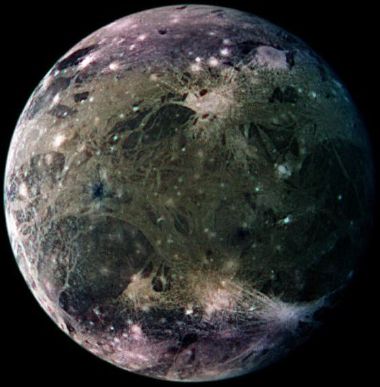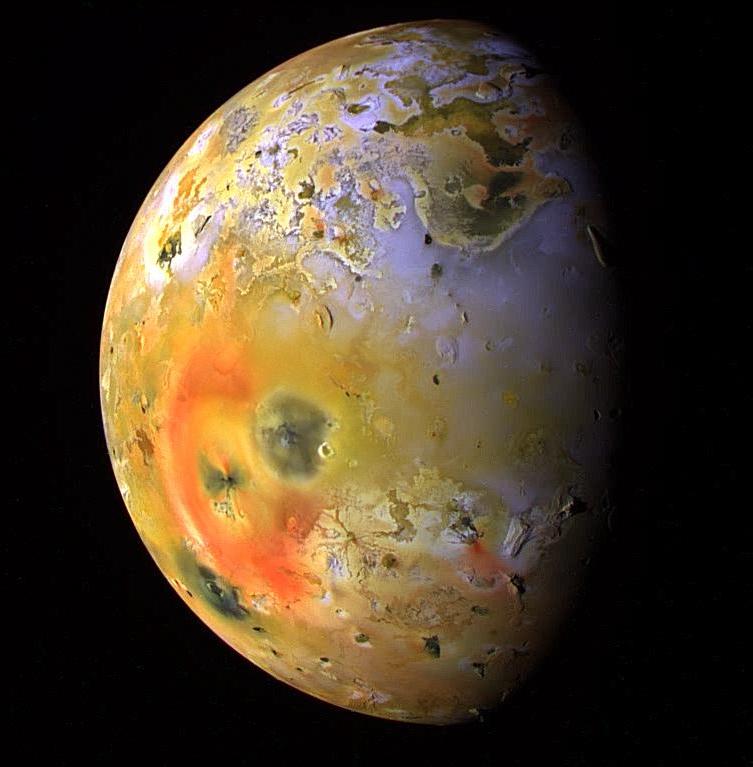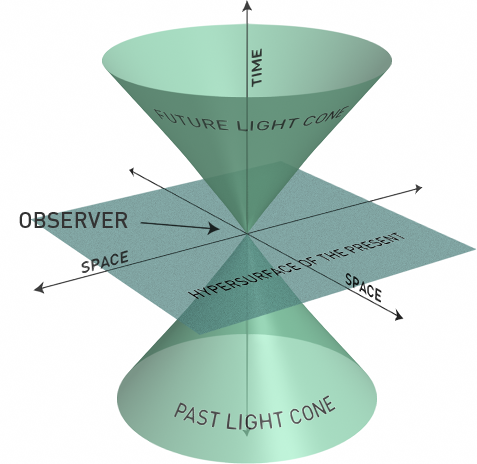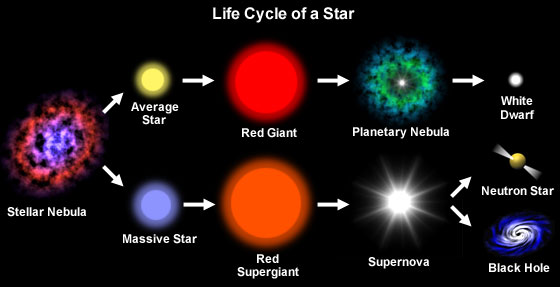Most people know of the famous gas giant, Jupiter. It's a tan color with many different patterns that can be seen below. It is the biggest planet in our solar system with a surface area of 23.71 billion square miles. It is located just after the meter belt separating the gas planets from the rocky.
One of the most famous qualities of Jupiter is the moons that orbit it. Jupiter has 50 named moons
according to NASA. Jupiter's moons are very different and unique. Some have very circular paths of orbits while others have oval or ellipse shaped orbit paths.Below you can see the complicated orbital patterns of the moons.

Jupiter also has a ring that's made up of three main parts. The main ring (part) is 7,000 kilometers wide but ends sharply about 129,130 kilometers from the center of the giant planet.Within the main ring is the orbital path of two of Jupiter's many moons, Adrestea and Metis. In between the main ring and cloud tops of the giant planet is an area known as the "Halo", it consists of a mixture of material and its about 20,000 kilometers thick. The final part of the ring is a part called the "Gossamer". It is made of tiny particles of dust and is only about 10 microns in diameter. Just for comparison a human hair on average is 75 microns across. The Gossamer exists from 129,000 kilometers from the center of the planet to 30,00 kilometers from the center. It like the main ring has two moon's paths in it, Amalthea and Thebe.
It might seem like the rings are huge, but they are really very faint and can barely be seen without direct sunlight. This is because they are all made up of dust particles. Scientists believe the rings were formed and continue to be supplied by small meteor crashes with Jupiter's moons. When the meteor crashes the dust is disrupted and thrown into space it then collects due to Jupiter's gravity and forms a ring. Scientists believe this because of all the moon orbital paths that exist in the rings. Below you can see the parts of the ring and the moons the obit within them.

Adrestea, Metis, Amalthea and Thebe all have something in common. They
are all shepherd moons, meaning moons inside or very close to a
planet's rings (in this case Jupiter's). A shepherd moons does many
things but one very important thing it does is help the rings keep
their shape and form, as well as "sweeping" up ant debris that happened
to float in the way. It does this by using the it's strong gravity the
acts like a ejection system because when something comes within range of
it, it is thrust away. Below you can see a shepherd moon inside a ring and the gap it's gravity is creating.
422,000 kilometers from Jupiter a moon called Io orbits. Io is very unique like many moons. It is the most volcanically active object in the solar system. It is so active that the volcanic plumes from the over 400 volcanoes at the surface, rise up to 190 miles high. Some of the many volcanoes erupt molten rock but others erupt molten sulfur compounds. The volcanoes erupting molten sulfur compounds cause the color and color change of the planet that can be seen in the picture below. The volcanic activity on Io is due to the sub-surface liquid that is so hot and constantly moving to try and reach the surface to relive the heat and pressure. Due to the constant moving of the liquid, holes created by craters are always filled.
Io is also the third largest known moon of Jupiter and is fifth known moon from the planet.
Also because Io is so close, the giant moons known as Europa and Ganymede the throw off its orbital path so it's path has the most drastic change in its distance from Jupiter. Because of this drastic change Io has very extreme tidal bulges. The bulges that can be up to 330 feet of solid ground bulging.
Scientist believe that the core of Io is Iron, the atmosphere is sulfur dioxide, and it is mostly made of either molten sulfur and it's compounds or silicate rock. Io is also cuts through the magnetic lines of Jupiter. This means that Io acts like an electric generator. Sometimes the planet holds up to 400,000 volts of across it. It also can create a current of up to 3 million amperes that travels to Jupiter's upper atmosphere resulting lots of lighting.
Io in the roman myths was the daughter of Inachus. The planet got the name Io because Jupiter (in the myths) loved Io, so the planet closest to Jupiter naturally would be Io.
Another moon of Jupiter is Europa. Europa is a little smaller than our moon and is phased locked meaning the same side of Europa always faces Jupiter. It revolves completely around Jupiter every 3 and a half days.
Europa is thought to have an iron core surrounded by a rocky mantle with a complete surface covered in salty ocean water. The ocean is very deep however due to the fact Europa is so far from the sun the ocean surface is always completely frozen over.
Europa has an eccentric orbit meaning that it revolves Jupiter in a non-circle way. Due to the eccentric orbit the tides on Europa change drastically causing major shifts is the ocean water beneath the layer of ice resulting in cracks.
Another interesting thing the eccentric orbiting causes is the heating of the planet more than it would normally be. Jupiter heats itself more than it gets warmth from the sun so it can heat Europa and it's surface oceans.
Because Europa has an icy surface, with more than twice as much water as we have in our own ocean, it is thought by scientist to be a possible home for life. Under the ice may be the key to alien life forms. "Europa has the liquid water and elements, and we think that compounds like peroxide might be an important part of the energy requirement. The availability of oxidants like peroxide on Earth was a critical part of the rise of complex, multicellular life." says Kevin Hand of NASA. What Hand is saying is that we know Europa has two of the three key ingredient needed for life to form and or exist.
Ganymede is the another very interesting moon of Jupiter. It is the 7th moon from Jupiter and the largest moon in the solar system. Ganymede has a rotation speed of 7.115 days and a year length of about 7.15455296 Earth days.
As mentioned before Ganymede the largest moon in the solar system. It is bigger than Pluto and Mercury! If it were not revolving around Jupiter and instead around the sun it would easily be classified as a planet. It has a volume of 76,304,506,998 kilometers cubed and a density of 1.942 g/cm cubed.
Ganymede has three general layers, the first or outer layer is an ice shell, its very thick (thought to be around 497 miles thick). The next layers are a rock like layer surrounding the metallic iron core.
Although Ganymede is not thought to be able to support life, astronomers found some evidence of what's thought to be an extremely thin oxygen layer. As well as oxygen evidence, irregular lumps have been discovered under the very icy surface of Ganymede. The lumps are probably rock formations of some kind that are either suspended by the very strong thick ice that has been frozen for the life time of the planet or are formations at the bottom on the ice layer.

Callisto is the third biggest moon in the solar system with a volume of 58,654,577,603 km cubed. It's about the size of Mercury.
The interior of Callisto is thought to consist of an inner rocky core and an outer core or mantle of ice. The surface is twice as bright as our own moon!
It like most moons recives craters however it is the most crater object in our solar system. Due to it's very thin atmosphere.
One interesting fact about Callisto is that it has the oldest known landscape in the solar system dating back around 4 billion years ago. It is thought to be "long dead" meaning it is thought not to have any geologic movement or changes.

The first four
moons of Jupiter discovered were Io, Eurpoa, Ganymeade, and Callisto. They are known as the Galilean moons because, they were discovered
by the famous astronmer Galileo Galilei in 1610. He found the moons after he improved his telescope and the moons lead to his theory (now known fact) that all planets including the earth revolved around the sun. The moons are also the four largest moons of Jupiter, they are all larger than Pluto. Below you can see the Galilean moons in the order they are from the Jupiter.






















